In Norse mythology, the gods were the superheroes of their time. Some are the inspiration for the superheroes of today. Great warriors have always required magical artifacts that only they can wield in order to cause a change in the world. The weapons of the Norse gods are some of the most famous in human history.
Some of these artifacts brought the gods immense power and wealth, others ill luck and destruction. These are the enchanted objects the Aesir and Vanir gods used to do battle with their foes and to rule the heavens above the wide lands of Midgard.
Andvaranaut, ‘Andvari’s Gift’
The Andvaranaut is the golden ring cursed by the dwarf Andvari as he handed it, under duress, to Loki, god of mischief. The ring is a talisman with which to find more gold and was the true source of Andavari’s great wealth.
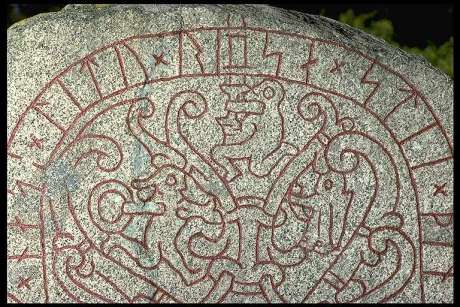
By Bengt A Lundberg , https://creativecommons.org/licenses/by/2.5, via Wikimedia Commons
Loki stripped the dwarf of his wealth and also demanded the ring. Andvari had no choice in the matter but wedded a curse to the ring as it left his hands. Loki had no fear of the dwarf’s magic but lost the ring in payment for the life of Otr, a shapeshifting dwarf he slew in the form of an otter.
The ring passed to Otr’s father Hreidmar who was slain by his son Fafnir who transformed himself into a dragon. The life of Fafnir was in turn ended by the hero Sigurd who gifted the ring to Brynhildr, passing on the curse. Sigurd later dies, murdered in his sleep, Brynhildr on the point of her own sword.
Balmung/Gram/Gramr/Nothung
This is the sword used by Sigurd to slay Fafnir the dragon. The weapon is gifted to his father Sigmund by Odin, who appears as a stranger during his sister’s wedding feast. He embedded the blade within a tree in the feasting hall and of all who try to withdraw the sword only Sigmund succeeds.
The sword is later broken by Odin but then recast for Sigurd, son of Sigmund, that he might put an end to the barren reign of Fafnir over the land stolen from his father Hreidmar.
Bodn
Bodn is one of three vessels containing the ‘Mead of Poetry’ made from the blood of wise Kvasir. This magical being, created from the saliva of the Vanir and Aesir, was a traveler and teacher, generous in his knowledge and able to answer any question.
The dwarves Fjalar and Galar slew him and drained his blood into three containers. There they mixed it with honey to form the Mead of Poetry which inspires the gods to this day.
Brisingamen, ‘Gleaming Torc’, ‘Torc of the Brisings’
Belonging to Freya, the Brisingamen necklace was forged by the master dwarf smiths, Dvalin, Grerr, Alfrigg, and Berling. The goddess of love paid a high price for her gleaming necklace. The dwarves demanded that she spend a night of love with each of them in return for their masterwork.
Draupnir, ‘The Dripper’
The magical ring Draupnir was forged by master dwarf smiths Sindri and Brokkr. The ring is one of three gifts created by the brothers, the other two being Mjolnir and Gullinbursti.
Every 9th-night Draupnir drips 8 new rings, equal in weight, value, and beauty to its parent. The ring comes to a sad end, however, when Odin places it on the funeral pyre of his beloved son Baldur.
Dromi, ‘Fetter’.
The second of the fetters forged by the gods to trick Fenrir into captivity. This bond was stronger than the first, but so was the great wolf. Despite their best efforts he broke free, shattering Dromi easily, and causing the gods to call instead upon the skills of the black elves to forge a greater bond. They managed to bind the wolf in the end, at the same time Tyr lost his hand.
Eldhrimnir, ‘Fire-Sooty’.
The boar Saehrimnir is served to the gods and einherjar every eve in the heroes’ hall of Valhalla. The animal is reborn each morning to be butchered and cooked anew by chef to the gods Andhrimnir. The cauldron in which the meat is cooked is named Eldhrimnir.
Forseti’s axe
The god of justice and reconciliation has a golden axe that he carries over his shoulder. Forseti appeared to the ancient Frisians in their time of need and guided them across the sea using only his war axe for a rudder.
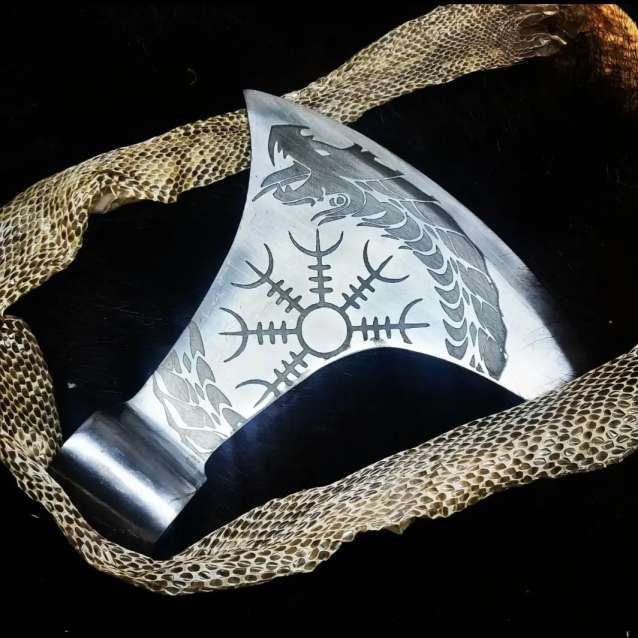
When they reached land he cast his weapon to shore and on the spot it landed a spring appeared. Forseti revealed to them a set of law codes by which to live and then vanished with his axe.
Freyr’s Sword
The god of sunshine and fair weather possessed a sword that fought without aid from the bearer, making its owner all but invincible. Freyr traded this magical artifact for Gerd, his giantess wife’s hand in marriage.
The sword now lies with the jotunn and it is said that Freyr will die at the point of his own blade, wielded by the fire giant Surt at Ragnarok.
Gioll
The Gioll rock is located a mile below ground. Fenrir the wolf is bound to this giant boulder by the unbreakable chain Gleipnir. The chain is fed through a hole in the rock and binds the wolf fast to the spot.
Gjallarhorn, ‘Hollering Horn’
Heimdallr possesses a horn so loud that it can be heard throughout the worlds. The guardian of the Bifrost used this horn to take a deep draft from the Mimisbrunnr making him one of the wisest beings in the 9 realms.
When the time of Ragnarok comes, Heimdallr will alert all races of beings by sounding the alarm on the Gjallarhorn.
Gleipnir, ‘Fooler’
This is the third of the bonds used by the gods to subdue Fenrir the wolf. Their own efforts to forge a chain were no match for his strength. This third however, created by the black elves, and tempered by their magic, proved too great for him.
Although seemingly light, Gleipnir is stronger than any other chain and is said to be made of six carefully chosen ingredients:
The sound of a cat’s walk
The beard of a woman
The roots of a mountain
The sinews of a bear
The breath of a fish
The spittle of a bird
One day, at the end times of Ragnarok, even this chain will break unleashing Fenrir upon the worlds.
Gram
Another name for Balmung, the sword of Sigurd, the dragon slayer.
Gridarvölr, ‘Gridr’s Staff’
The giantess Gridr loaned her enormous, unbreakable staff and power belt as well as iron gauntlets to Thor who was without his own weapons. He used the staff to cross the expanse of the Vimur river and break the backs of Geirrod the giant’s daughters, he then smashed the skulls of Geirrod’s numerous households.
Gungnir, ‘The Rocking’, ‘Swaying One’
Cunning Loki convinced the sons of Ivaldi, under supervision from master smith Dvalinn to fashion several magical artifacts of dwarvish craftsmanship. Among them is Odin’s spear Gungnir which never misses its chosen target and always kills its victim.
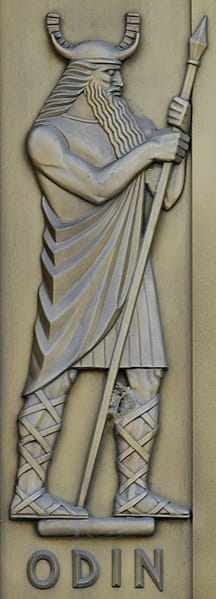
The spear is fashioned from the wood of Yggdrasil and is inscribed with runes traced by Odin himself to add to its power. The Allfather will wield this mighty weapon during the end times of Ragnarok.
Hlidskjalf
When the Allfather sits upon Hlidskjalf, he can see everywhere throughout the worlds, regardless of distance. The hall of Valaskjalf, the ‘Shelf of the Slain’, houses the throne and features a pure silver thatch.
Freyr first set eyes on the maiden giantess Gerdr, in the faraway Jotunheimen, while sitting on this throne, and instantly became besotted with her beauty.
Hofud, ‘Man-head’.
Heimdallr, guardian of the Bifrost and keeper of the Gjallarhorn possesses a sword known to all as Hofud or ‘Head’. It is this sword that he will use to battle and ultimately slay Loki during the final battle of Ragnarok.
Hringhorni, ‘Ring Horn’, ‘Stem-circled Ship’.
Wise, beloved Baldr owned a ship so great that it required a giantess to launch it after his death. It was described as the greatest of all ships and was used for the god’s funeral pyre after he was murdered, indirectly by Loki.
Hymir’s Cauldron
When the gods ran short of mead they needed a cauldron to brew more. Thor demanded of Aegir, the great jotunn who commands the sea, that he should supply them with drink. Aegir agreed to do so, but only if he was supplied with a cauldron large enough for the task.
Tyr the god of justice and war, proposed that Thor should find just such a cauldron at the home of his father, the giant Hymir. Together they brought the huge vessel, reputedly 5 miles deep, back to Aegir and he used it to brew the gods their vast supply of mead.
Járnglófar/Járngreipr, ‘Iron Gauntlets’
Thor has three magical artifacts, where the most famous one for sure is his hammer Mjolnir. However, he also has the belt of strength, Megingjord and the iron gloves Járngreipr. While Thor can wield Mjollnir just fine by himself, I belive the lore was that the belt and gloves, each or in combination, doubled his already immense strength.
Loki turned himself into a gadfly to pester Brokkr, the dwarf master smith as he forged the hammer and caused him to leave the handle short. As the hammer is so prodigiously heavy, Thor must have the gloves to ensure his grip upon it.
Idunna’s apples
The secret to the immortality of the gods lies with the goddess Idunn, the giver of eternal youth. She provides apples to the gods that keep them young, without these, they too will grow old and weak.
The apples shine with a golden hue and are kept by Idun in her basket. On one occasion the goddess was kidnapped by Loki and given to the jotunn Thiazi. In her absence, the gods quickly began to age and weaken. They guard her, therefore, with their lives.
Laevateinn/Haevatein, ‘Sure Striking Arrow’
Loki is mostly associated with theft and trickery. There is, however, one artifact forged by the god himself and that is wand, or possibly a sword. It is a magical object, as elusive as the god himself. Some describe it as a sword, others a piercing dart, yet others say it is a wand. Perhaps all three are correct.
Even the name has multiple meanings including, ‘sure striking dart’, ‘wounding wand’, ‘wand-of-destruction’, and even the ‘damage twig’.
This mysterious weapon, forged by Loki, is said to be the only weapon that may defeat the cosmic eagle Vidopnir who sits atop the world tree Yggdrasil.
Loeding/Leyding
The gods created two fetters with which to bind Fenrir the wolf. The first of these was Loeding, which they forged to the best of their ability. To the astonishment of the gods, Fenrir freed himself from their mighty chain with little more than a shrug.
Megingjörd, ‘Power Belt’
The thunder god has three magical artifacts to enhance his power. Mjolnir his hammer, Jarnglofar, his iron gauntlets to help him wield Mjolnir, and Meginjord, his belt of power.
This belt doubles the strength of the wearer making the already immensely powerful Thor a being of unimaginable power.
Mjölnir/Miollnir, ‘Lightning-maker’
From his shoulders he lifted the kettle down;
Miöllnir hurled forth towards the savage crew,
and slew all the mountain-giants,
who with Hýimir had him pursued.
(Hymiskvida, The Lay of Hymir, Benjamin Thorpe Translation)
The hammer Mjolnir is surely the most famous of all the artifacts of the gods. In Midgard, all mortals know its furious sound as Thor causes the lightning and thunder to blast across the sky.
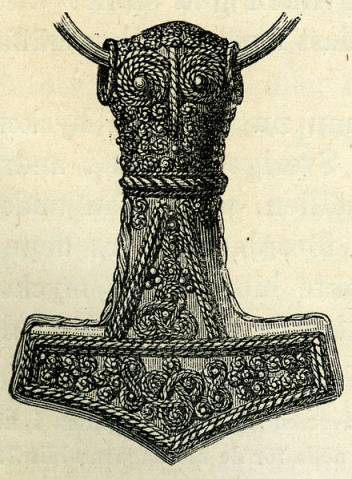
In Jotunheim, the countless battered jotunn skulls equally recognize the mighty Thor and his unbreakable Mjolnir for their destruction.
The dwarf master smiths Eitri and Brokkr forged the weapon, infusing it with many magical qualities. Mjolnir always returns to its bearer when thrown, can heal and bless as well as destroy, always strikes its intended target, can kill any enemy, and may destroy any object.
Naglfar/Naglfari, ‘Nail Farer’
Hrym steers from the east, waters rise,
the mundane snake is coiled in jötun-rage.
The worm beats the water, and the eagle screams:
the pale of beak tears carcasses; Naglfar is loosed.
That ship fares from the east:
come will Muspell‘s people o’er the sea, and Loki steers.
The monster’s kin goes all with the wolf;
with them the brother of Byleist on their course.
(Voluspa, Prophecy of the Volva, Benjamin Thorpe Translation)
This sickening ship is constructed entirely from the finger and toenails of the dead. At the time of Ragnarok, it will be freed upon Jormungand’s flood. The giant Hrym will pilot the vessel along with Loki and a crew of the damned to wreak havoc upon mankind.
Odrorir/Odrerir
The Mead of Poetry inspires all those who taste it with verse and wisdom. It is composed of the blood of Kvasir, a being formed from the spittal of the gods. Slain by the dwarves Fjalarr and Gjalarr, they used a kettle, named Odrorir to mix Kvasir’s blood with honey to make the magical brew.
The mead is now stored in two vats and this kettle. Some call the mead itself Odrorir, after the vessel used to mix it.
Ridill/Refil
The hero Sigurd slew Fafnir, guided to his lair by the dragon’s dwarf brother Regin. When the deed was done Regin cut out his brother’s heart with his sword Ridill and cooked the meat for Sigurd to consume.
Sif’s Golden Hair
Loki removed all of Sif’s hair while she slept. When Thor learned of the mischief his anger was so great that Loki traveled to Svartalfheim, promising to bring back a golden hair piece more beautiful than Sif’s original locks.
The sons of the master smith Ivaldi not only created a head of golden hair more comely than the original, but they created the ship Skidbladnir and the spear Gungir as well. This gleaming mane is what the goddess Sif wears today.
Skidbladnir, ‘Made of Thin Wood’.
The sons of Ivaldi crafted the marvelous ship of the gods, Skidbladnir, to win their bet with Loki. They gifted this vessel to Freyr, and it can hold all the Aesirs. They made the ship from razor-thin wood, which allows it to fold small enough to fit within a single pouch.
The dwarves invested such magic into their creation that it sails not only the seas but also on the wind. The sails of Skidbladnir are always full of fair wind giving the vessel supernatural speed.
Son
The blood of wise Kvasir was divided into three vessels. Son is one of two vats that were used to contain the poet’s lifeblood for the making of mead.
Surtalogi – Sword of Surtr
The prophecy foretells that the fire giant Surt will rise from Muspelheim at Ragnarok and devastate worlds with his flaming sword. Although not widely known, people believe the sword’s name is Surtalogi.
Without the use of his weapon, magically charmed to fight independently of the wielder, Freyr cannot vanquish the giant and live. The foes die together at Ragnarok.
Svalin, ‘Cold’
Svalinn is his name,
he stands a shield before the sun,
the shining deity.
I know that the hills and
the sea would burn,
if it were to fall from its place.
Svalin is a magical shield, icy in nature, that protects Midgard from the heat of the goddess Sunna as she travels through the firmament.
Thor’s Chariot
Thor rides his war chariot into battle drawn by two goats, Tanngrisnir and Tanngnjostr. The thunder god almost exhausts his goats as they draw the chariot beneath him in the battle to slay Hymir and his host of jotunn followers.
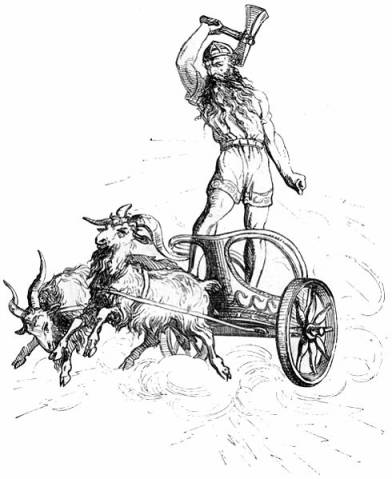
Together the goats and chariot give Thor the ability to travel far and wide through the Nine Realms and great speed with which to outmaneuver his enemies.
The Mead of Suttungr, ‘The Mead of Poetry’
Poetry and wisdom are closely related in the world of the gods. Though not an artifact, the blood of Kvasir was used to create the sweet mead of poetry. The wisest man in all creation who could answer any question and recite any poem.
The murderous dwarfs Fjalar and Galar slew him and drained his blood to make a brew that would confer upon them Kvasir’s knowledge and inspirational words.
The mead was then passed to the jotunn Suttungr in reparation for the death of his father Gilling at the hands of the dwarfs. Although Suttungr stored the mead carefully away, Odin retrieved it for the use of the gods and bestows it upon those deserving enough to experience the inspiration of true poetry.
Vidar’s Boot
Vidar is a son of Odin and some say second only in strength to the thunder god himself. At the final war of the gods, Odin will ride out to do battle with Loki’s child the Fenris wolf. Although he is the wisest and most powerful of the gods, the beast is prophesied to swallow the Allfather into his vast maw.
The gods will despair at the loss of Odin, but Vidar will save the day by wielding a weapon crafted throughout the ages for the task.
While Fenrir struggles helplessly with the boot Vidar will hack him to pieces with his sword avenging the death of his father and surviving the battle. We can all do our part by providing scraps of leather left over from the making of our boots as material for Vidar’s battle-winning shoe.
